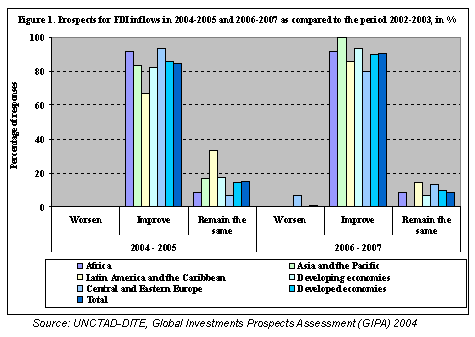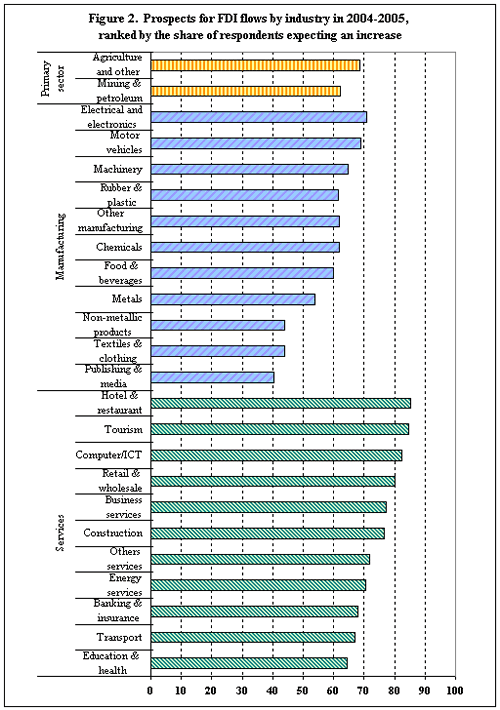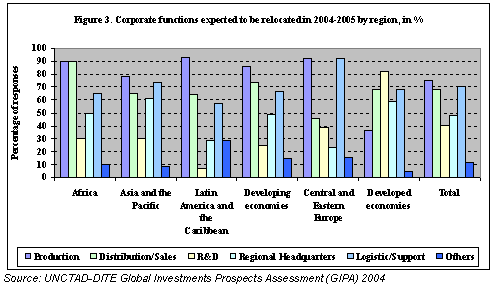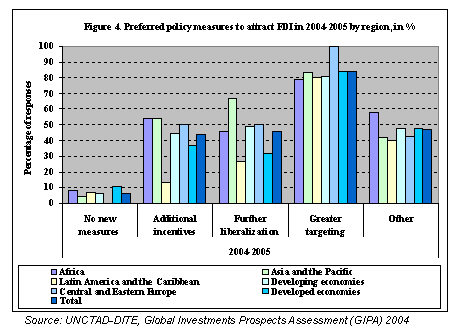Investment promotion agencies (IPAs) worldwide are increasingly optimistic about prospects for an increase in FDI flows over the next four years, according to UNCTAD´s 2004 survey of IPAs, released today.
The results confirm the findings of a related survey of international investment location experts which UNCTAD conducted jointly with Corporate Location magazine (see UNCTAD/PRESS/PR/2004/005 of 13 April).
Among the main findings of today´s survey:
- IPAs are very optimistic about FDI prospects in the medium term (2006-2007), with 91% of respondents believing they will improve. They are slightly less optimistic about the short term (2004-2005), which 85% of respondents believe will improve (figure 1). No IPA foresees a worsening of short-term FDI prospects, in contrast to the findings of the 2003 survey.
- Prospects are considered positive for the majority of industries. Globally, the top-ranked industries were hotels and restaurants, other tourism services and computers/ICT. Retail and wholesale, construction and business services among service industries, and electrical and electronics and motor vehicles among manufacturing industries also ranked high (figure 2).
- The United States, Germany, the United Kingdom and France are viewed as the most important sources of FDI, followed by China and Japan. For the first time ever, a developing country (China) has made the list of the top five FDI source countries.
- IPAs consider production, logistics and support, as well as distribution and sales, as the types of corporate functions most likely to be relocated abroad by transnational corporations (TNCs) (figure 3).
- Most IPAs expect FDI to come in the form of green-field investment, accounting for about half of the IPAs´ responses. Almost 27% expect mergers and acquisitions (M&As) to be the preferred mode of entry, while another 23% named other, mainly non-equity, forms of international expansion (such as licensing).
- IPAs are stepping up their efforts to attract FDI, using targeting in particular, and are not shying away from offering additional incentives (figure 4).
The survey revealed a remarkable consistency in the agencies´ assessment of various regional prospects, with some nuances:
Asia and the Pacific. Prospects for 2004-2005 are expected to be bright and to improve even more in the medium term. Motor vehicles and machinery are the two manufacturing industries for which prospects are particularly positive, while in the services sector there is also significant optimism for FDI in tourism, construction and computers/ICT.
Latin America and the Caribbean. Medium-term prospects are seen to be improving for this region as well, with 86% of respondents expressing considerable optimism for increased FDI. However, while medium-term expectations are significantly better than those for the short term, they still lag behind those of all other developing regions. This somewhat subdued optimism might be explained by such factors as the slow economic recovery in some countries. Optimism is more marked for FDI in the services sector, particularly for hotel and restaurants, retail and wholesale trade, and tourism.
Africa. The survey´s picture of Africa is especially bright for both the short and medium term. Responses from African promotion agencies were typically more positive than for other regions. Agriculture and food processing scored particularly high in terms of their prospects for attracting FDI. Prospects for services also did well, most notably in the retail and wholesale sector (where 100% of respondents expect an increase in FDI prospects) and in tourism (95% of respondents).
Central and Eastern Europe. Respondents are very optimistic about this region´s prospects for the next two years, but considerably less so about the medium term. The wariness might stem from expectations that a wave of FDI inflows into the new EU member countries after their accession this June might subsequently peter out. Several manufacturing industries (electrical and electronic equipment, metals and mineral products, motor vehicles and other transport equipment, and machinery and equipment) stand out, with the majority of IPA executives expecting an increase in FDI. IPAs also anticipate major improvements in the prospects for most services.
Developed countries. The overall picture for developed countries is as rosy as for most other regions. Optimism is on the rise for their medium-term prospects, but somewhat less so than for some developing regions. In contrast to these findings for developed countries as a group, IPAs were particularly optimistic about the European Union, with all respondents from the region anticipating improved FDI prospects during 2004-2007. They are especially sanguine about prospects for business services and computer/ICT, machinery, and publishing and media.
Overall, the findings suggest that IPAs feel that the worst is over and that they are now upbeat about prospects. Barring unforeseen adverse events, UNCTAD believes that their expectations will likely be met if the world enters a new cycle of growth and prosperity as many experts are predicting. The survey also provides insights into future policy trends. "What has become obvious from the findings of this survey is that, even when optimism prevails, tactics for attracting FDI continue to become more aggressive", says Karl P. Sauvant, Director of UNCTAD´s Division on Investment, Technology and Enterprise Development. IPAs are using a combination of policy and investment promotion tools as part of their strategy to compete.
IPAs are an important antenna for picking up trends on FDI flows and TNC location strategies, as they respond in their day-to-day operations to foreign investors´ enquiries and facilitate investors´ locational exploratory missions and feasibility studies. The overall response rate to this survey, which covered 158 national IPAs, was 63%. Its results will be complemented by and cross-checked against surveys of the largest TNCs worldwide and of international investment experts who typically assist corporations in their overseas location decisions. The results will also be cross-checked against available hard data on future macro- and microeconomic developments, including forecasting data on GDP growth. |
ANNEX
Tables and Figures


Source: UNCTAD-DITE, Global Investments Prospects Assessment (GIPA) 2004




